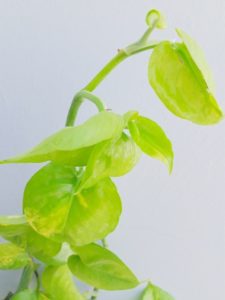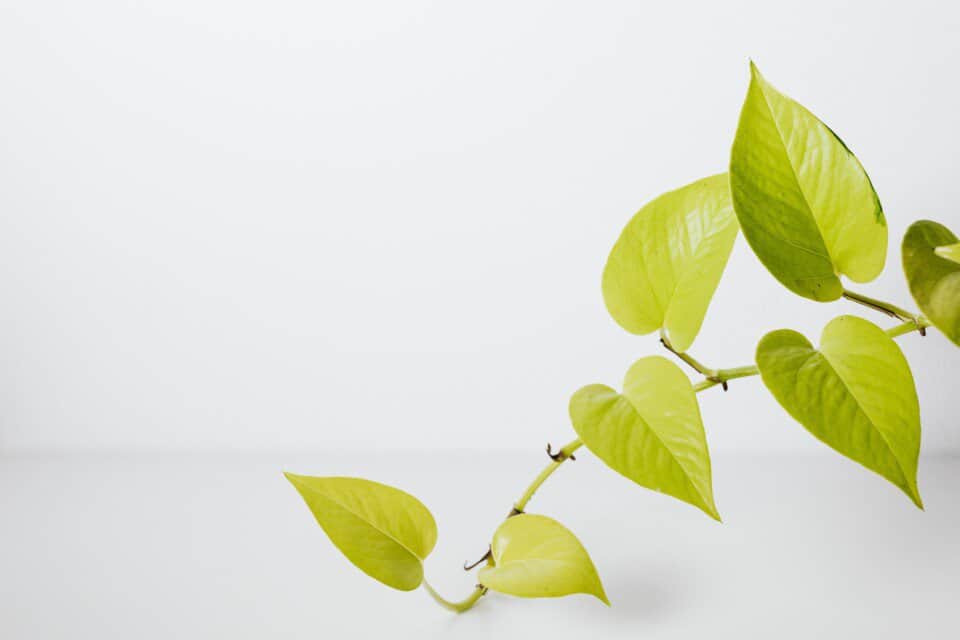Some links in the post are affiliate links and I get a commission from purchases made through some links found in the post.
I know the feeling. One minute, you have a healthy vine sprawling across the room. And the next, you start catching a glimpse of yellowing on the pothos leaves.
The change is gradual, and you first mistake it for aging. But then the color spreads, almost taking over the entire leaf surface. Then the worst happens – the leaf falls off or turns brown, dying prematurely.
Should you have concerns about such changes? Oh, yes! Yellowing in older leaves is normal as it results from the loss of chlorophyll as the leaves die.
And that’s something you can ignore. But if it bothers you so much, you can pluck off the dying leaves so you can enjoy a healthy-looking pothos.
If your pothos is turning yellow whilst having younger leaves, you need to look into the likely issues that often result from watering, feeding, and lighting problems. You can either be giving your plant too much or too little of these essential factors, hence causing it to retaliate by yellowing.
This guide gets into the main reasons your pothos leaves are turning yellow and what you can do about it:
Why Are My Pothos Leaves Turning Yellow?
 Leaves contain chlorophyll (the green coloring matter) which enables them to make food. And to do this, they rely on water, light, and nutrients, converting them into energy used in healthy plant development.
Leaves contain chlorophyll (the green coloring matter) which enables them to make food. And to do this, they rely on water, light, and nutrients, converting them into energy used in healthy plant development.
So, when a leaf lacks this green coloring matter, it loses its ability to support plant growth.
And instead, it becomes a liability to the rest of the plant because the other leaves must make food to help heal and support this damaged or dying leaf.
Pothos leaves turning yellow when they get older is normal – it’s part of the aging process. But if the yellowing starts showing in the younger leaves, you have a reason to feel concerned.
That’s because the plant heavily relies on these leaves to make food (and thus energy) to support the entire plant.
So, what can cause this loss of chlorophyll, and what can you do about it?
1) You Have Overwatered the Pothos
Plants need water to survive. However, there is a limit to how much water they can withstand without drowning – yes, plants can drown when fed too much water.
And often, when yellowing shows in a plant, overwatering is usually the first culprit you need to uncover or rule out. That’s because it is also known as the silent killer.
After all, it attacks from the base and only shows signs when the damage is extensive. And if you leave your pothos in this state too long, the plant will eventually die.
But how do plants drown, and how does this relate to yellowing? It all starts when plant roots sit in excess water.
This moisture robs the plant of the chance to take up oxygen and thus creates an environment in which fungi can thrive.
These fungi start feeding on the plant roots, and in a short while, the roots cannot keep up with moisture and nutrient absorption.
So, the plant ends up deprived of two main photosynthesis elements. And even when you place it in adequate light, it doesn’t recover because the problem lies within the roots.
If you do not move the plant to a better location and get rid of the damaged roots, the stem also gets affected, turning mushy and affecting the transfer of water and nutrients.
When a plant is this compromised, death is almost inevitable.
What causes overwatering? All overwatering issues result from mistakes on the part of the gardener. I do not mean to pass judgment here, but you will understand what I mean once I list the likely causes:
- You water your pothos even when the soil has not dried out,
- You water your pothos frequently, even in the colder months,
- The potting soil used for the pothos is not well-draining,
- The pothos pot does not have sufficient drainage holes, and
- The pothos is in low light conditions.
Can you relate to any of these issues? If yes, you may want to look out for the following signs of overwatering:
- The plant’s leaves start turning yellow and turning soft. They also appear droopy, almost as if they lack support structures,
- The yellowing on the leaves is not central to one leaf but instead shows on several leaves,
- The yellowing is not gradual, but instead, it has a sudden onset,
- Black spots may appear on the leaves and other plant parts, and
- The stem may appear soggy.
The presence of some of these signs will depend on how much the overwatering has developed. If it is in the early stages, soggy stems and black spots may not be on the leaves.
But in the later stages where root rot has begun, these signs may show as they result from fungal infestation.
Dealing with Overwatering
As I said, overwatering is deadly – I would advise you to lean more on underwatering than overwatering your plant. There are several ways to deal with this issue:
a. If Root Rot is Not Present
When overwatering is in its early stages, root rot will not have started. As such, the plant will have yellowing leaves spread throughout the plant. But its stem and roots will not be mushy.
To be sure that your plant is in this stage, you will need to inspect its roots by uprooting the pothos from the pot. You can do this by laying the plant on its side and tapping on the sides of the pot.
You can then tug the pothos out of the pot and look at the roots. If they appear soggy and white, fungal rot has started. If not, you can get rid of the yellowing leaves.
While root rot may not have started, overwatered leaves can harbor pathogens that can affect the rest of the plant. I will take you through how you can avoid such issues moving forward.
b. If Root Rot is Present
 When root rot begins, the damage to the plant is often fast and quite extensive. You must thus stop the damage in its tracks by:
When root rot begins, the damage to the plant is often fast and quite extensive. You must thus stop the damage in its tracks by:
- Cutting off the damaged roots – anything that is black or soggy will have to go,
- Treating the remaining roots with fungicide,
- Leaving the plant in a shaded and airy spot for an hour, and
- Repotting the pothos in nutrient-rich and well-draining soil.
Sometimes, the damage to the roots may be so extensive that cutting them back results in retaining just a small portion of the plant.
You can still try your luck with what’s left because the pothos is a highly resilient plant. But if it’s too small, get a cutting from the plant and use it to propagate another plant as you discard the parent plant.
Can the pothos turn yellow after transplanting? Yes! Your pothos may not take too well to its new home and may relay its distress by turning yellow and experiencing stunted growth.
You can prevent shocking the plant too much by watering the potting soil before you place the pothos in it. Also, keep an eye on the temperature and humidity ranges, which affect how well the plant adapts to its new environment.
Preventing Overwatering
Too much water can kill your plant. So, how can you keep it at bay?
- Only water the pothos when the soil is completely dry. You can check by digging two inches into the soil and testing how wet the earth feels. If you are unsure, you are better off not watering the plant. Or you can get a moisture meter so you can avoid the guesswork.
- Ensure you water the pothos thoroughly until the excess water drains from the pot – this will reduce the need to water the plant frequently.
- Use a well-draining potting mix. Peat and perlite-based mixtures are often the most preferred. While amending your soil with compost is good for a nutritional boost, avoid doing it often as it increases the water retention rate of the potting mix.
- Ensure the pot has enough drainage holes. You can even add more if you think they are not enough.
- Place the pothos in a spot with enough light. The plant relies on the photons in the light to make food. And when they are not enough, it stops taking up as much water because photosynthesis takes a hit.
- Reduce watering in the colder months as the plant will not need it as much. Please keep checking the state of the soil by digging into it before watering it.
Also, in the days that follow the cutting off of the yellow leaves in the plant, water it sparingly. You do not want to trigger more fungal action.
2) You Have Underwatered the Pothos
Overwatering your plant is a no-no. But how about underwatering it? The pothos is a low-maintenance plant and can survive periods of neglect. However, it has a limit as to how much dehydration it can withstand. Why?
Photosynthesis comes down to the plant having enough moisture, light, and nutrients. And when you take away the moisture component, turgor pressure and cellular functions reduce.
Photosynthesis thus takes a hit, and as it reduces, some parts of the pothos start turning yellow– because of the reduced photosynthetic processes.
Luckily, figuring out if your pothos has suffered underwatering is easy. You can look out for signs like:
- The leaves start yellowing at the tips before spreading to the entire surface,
- The plant looks limp, which is a defense mechanism against more water loss,
- The leaves can start browning and curling, and
- The leaves can start falling.
Underwatering can result from many factors, most of which are the opposite of what causes overwatering. How so?
- You do not water the pothos even when the soil dries up entirely and leave it in this state for days to weeks,
- Your pothos potting mix has a high drainage rate and low water retention,
- The pothos pot may have too many drainage holes or may be too porous, thus wicking away a lot of moisture,
- The pothos may be in the full sun, thus increasing its rate of water loss via transpiration and evaporation, and
- You may not be watering the pothos enough in the summer when the temperatures soar.
Saving an underwatered pothos is often easy as all you need is to undo the damage you have caused.
Dealing with Underwatering
All your plant needs is moisture. And you can ensure it gets it by:
- Watering the pothos thoroughly and ensuring the excess water drains from the drainage holes. Use warm water for the first few days to avoid shocking the plant. The plant is weak at this point, and stress can overwhelm it and delay its recovery.
- Watering the pothos when the soil dries out – you can use a moisture gauge to help you know when to do this,
- Amending the soil with compost or other materials with a high water retention rate,
- Using a pot with fewer drainage holes or one with less porosity, and
- Moving the plant to a cool spot in the house, especially in the warmer months.
Please note that overwatering occurs if you are too generous with the water. As such, you should keep an eye on how much you water the plant moving forward.
3) The Pothos Leaves Are Sunburnt
 It’s no secret that plants rely on light to make food – they use the photons in the light to photosynthesize. And in the case of the pothos, full sun or partial shade is the best kind of light.
It’s no secret that plants rely on light to make food – they use the photons in the light to photosynthesize. And in the case of the pothos, full sun or partial shade is the best kind of light.
This light is close to what pothos get in the wild, which is often filtered or dappled light.
Even so, what constitutes full sun or partial shade in your home might be too much for the pothos leaves to bear. And when the light starts lying on the extreme end, the plant will react by increasing its sun protection.
Pothos leaves can produce pigments that shield them from the sun. But to do so, they must reduce the production of chlorophyll. So, eventually, the leaves start taking on a yellow hue as the other pigments take hold of the pothos.
You can tell that your pothos leaves are facing a light issue when:
- The loss of color is gradual: Instead of the leaves turning yellow at once, you will notice that the green matter becomes less visible over time. And if you do not act fast, the leaves will eventually yellow completely, affecting the plant’s ability to make food.
- The yellow color will increase over time: Once the yellow hue has taken hold, its intensity will increase. That is because other pigments photosynthesize well with high light intensity. So, the more light they receive, the more the plant will produce them.
Also, if the light also accompanies heat beyond what the pothos can handle, leaf burn (browning or spotting) may show on the leaves. It starts on the edges before spreading throughout the leaf.
Dealing with Too Much Light
The position of your plant will depend on the climate where you live. The pothos generally does well in USDA hardiness zones 10-12, which are pretty warm.
Thus, the full sun might not work for these regions all year round as it gets harsh in the summer. Also, you must consider the temperatures aligned with the light exposure you give the plant.
Once you start exposing the leaves to temperatures higher than 90 degrees Fahrenheit, trouble comes a-calling. It is best to leave the plant in a spot where the temperature falls below 85 degrees Fahrenheit.
As for the exact positions, you can play around with the following options to see what works best:
- Towards a south-facing window if you live in the northern hemisphere: These spots are ideal for bright and direct light, i.e., full sun. And if you live in a cool climate, you can place your plant in such a spot. If you live in the southern hemisphere, you will need to interchange this with a north-facing window.
- Towards an east-facing window: Morning sun, also referred to as partial shade or bright and indirect light, is quite gentle on the pothos leaves. Moreover, it contains enough photons to encourage photosynthesis.
Keep in mind that the positions will change with the seasons. For example, your pothos may not show signs of distress in the full sun in the spring.
But in the summer, this can change. So, observe how the pothos responds to a given spot and change it if the need arises.
4) Your Feeding Schedule is Off
The pothos is not a heavy feeder. But indoors, you may need to supplement the plant with some feed to account for its restricted habitat – it cannot feed off decaying matter like it would in the wild.
However, as much as fertilizer may be good for your plant, you can go wrong when using it in several ways:
- You can offer the plant more feed than it needs. When you do this, the plant ends up sitting in the feed, causing root burn. And like we saw under overwatering, when roots get damaged, the uptake of water and nutrients reduces, causing the pothos leaves to start turning yellow.
- You can provide the plant with too much of one nutrient. Take the example of where you want the pothos to produce more leaves. You may feel tempted to give it a lot of nitrogen. And this emphasis can cause an imbalance which can affect the hue of the leaves. The leaves may also start burning on the edges, indicating that they have developed nutrient toxicity.
- You may deny the plant a nutrient it requires to thrive. This point is the opposite of overfeeding. Rather than giving it too many nutrients, you may hold back on feeding the plant, forcing it to rely on potting mixes. Unfortunately, most of these mixes offer low to no nutritional value. And when the roots have no nutrients to take up, photosynthesis suffers. Moreover, the plant may show signs of chlorosis, yellowing on the entire leaves or the margins, stunted growth, etc.
The leaves of a pothos can be turning yellow due to any of these reasons. You thus must ask yourself which one you resonate with before you can figure out what to do next.
Dealing with Overfeeding
 If you think you have been giving your plant too much feed, you will need to cut back on feeding it for a few months. Then, when you resume, adhere to the following guidelines:
If you think you have been giving your plant too much feed, you will need to cut back on feeding it for a few months. Then, when you resume, adhere to the following guidelines:
- Only feed the pothos when it is actively growing, which should be in the summer, spring, and early fall,
- Feed the plant only once a month, and
- Use a balanced fertilizer. The ratios should be 10-10-10 or 20-20-20.
It is much easier to deal with an underfed plant than it is to deal with an overfed one. That’s because fertilizer burn can compromise the roots of the pothos to the point of killing them.
If you stop feeding your plant and it still does not show signs of recovery (all factors considered), you will need to repot it. That allows you to prevent further root damage and start with a clean slate.
Repotting the pothos is easy. Remove it from its current pot and inspect the roots. Then cut off any damaged parts and treat them with fungicide before moving the plant to a new potting mix.
In the weeks that follow, avoid feeding the plant. And instead, allow it to survive on the bare minimum as you work your way up to a consistent and reasonable feeding schedule.
Dealing with a Nutrient Imbalance
An imbalance signals that one nutrient is abundant and is more than the plant needs. So, the best way to deal with this issue is to stop feeding the plant for a few months. That will allow it to use the excess nutrient. Then, you will need to:
- Assess if the plant has recovered. If the pothos still seems weak even after you have stopped feeding it for over a month, you will need to check if root damage has occurred. If yes, you will need to cut off the damaged roots and repot the pothos in a fresh potting mix.
- Start using a balanced fertilizer. While you may feel tempted to feed the plant a specific nutrient, you should refrain from doing so. Instead, work with ratios 10-10-10 or 20-20-20.
Also, you will only need to feed the pothos from the spring to the early fall. Avoid feeding it in the late fall and winter as it will hardly use the nutrients during the cold months. You do not want to end up with an overfed pothos.
Dealing with a Nutrient Deficiency
Deficiencies are common in indoor pothos because of the poor quality of most potting mixes. Unfortunately, underfeeding affects the overall growth of the plant and slows its vigor. So, how do you get around this issue?
- Conduct a soil test and figure out which nutrients your plant needs. You may find it lacks magnesium, and this has caused the yellow patches on the leaves. Or the issue could be that the plant lacks iron which has resulted in the yellowing of the veins in the leaves. A soil test enables you to zero in on the issue and deal with it instead of using a one-size-fits-all approach.
- Find a feed that addresses the missing nutrient. For example, if nitrogen deficiency is the issue, you can use feeds rich in nitrogen to raise its levels. Do this gradually to avoid having an issue of an imbalance. Then when the nutrients are at par, you can start using a balanced fertilizer.
Like the other feeding issues above, you will need to feed the plant once a month and avoid doing so in the colder months.
Can Yellow Pothos Leaves Turn Back to Green?
Once pothos leaves have turned yellow, there is little you can do to change their color. The leaves may turn green depending on the cause of the change in hue.
However, because this is highly unlikely, it is best to focus on ensuring that the next set of leaves does not face the same issues as the yellowing ones.
You can leave the yellow leaves on the plant if they have not resulted from fungal infestations. Else, you will need to cut them off to prevent the pathogens from spreading.
Also, clipping the leaves is an option if the color change is unsightly and bothers you. Please use sterile cutting tools when pruning the pothos to prevent infesting it with pathogens and causing even more issues than before.
Final Thoughts
 The pothos is a low-maintenance plant that is quite hard to kill. So, whenever young pothos leaves take on a yellow or another color besides the characteristic green, you have likely deviated from the required care routine.
The pothos is a low-maintenance plant that is quite hard to kill. So, whenever young pothos leaves take on a yellow or another color besides the characteristic green, you have likely deviated from the required care routine.
Thus, it would help if you questioned what you have been doing and how it could have affected your plants. You can then figure out what you need to do more of or what you need to stop doing.
Happy Gardening!


